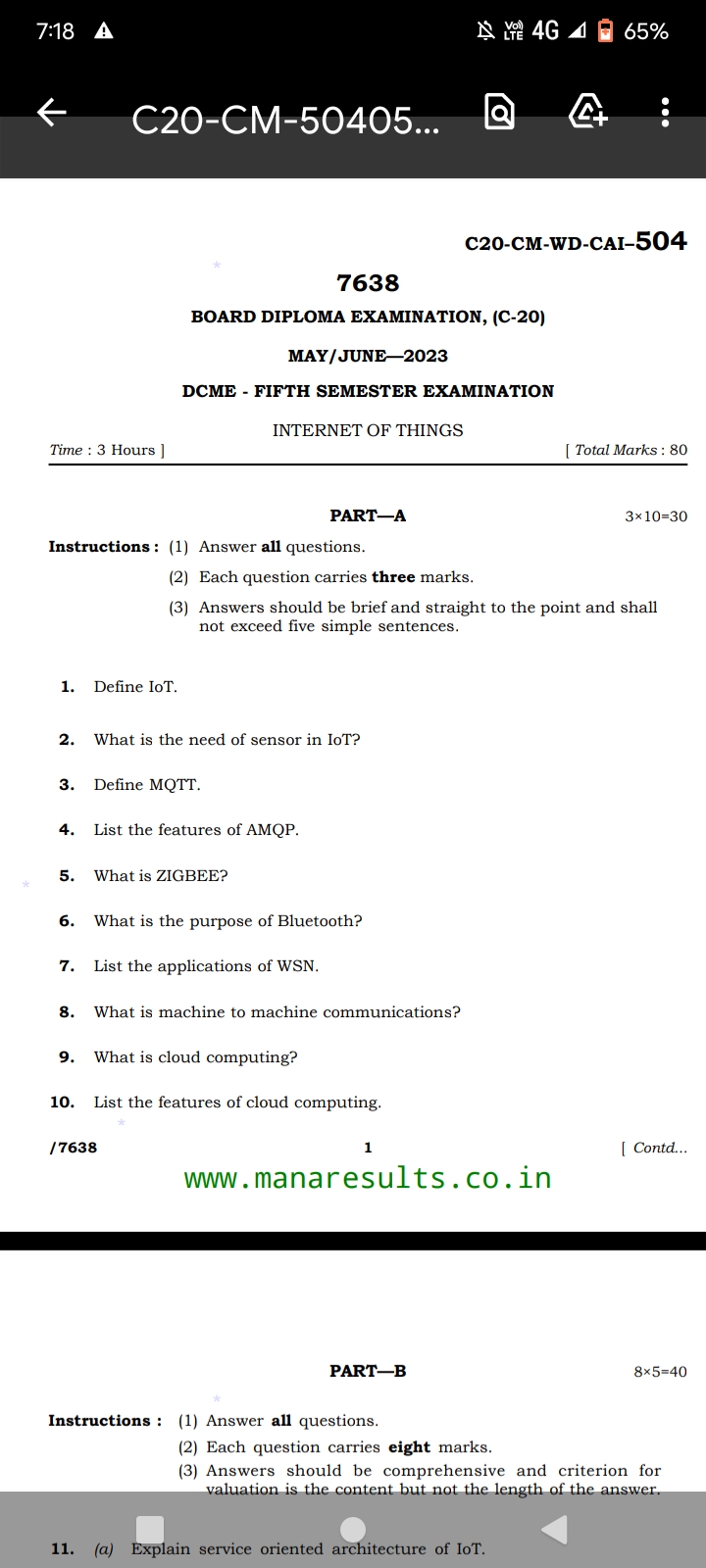1. Define IoT. 2. What is the need of sensor in IoT? 3. Define MQTT. 4. List the features of AMQP. 5. What is ZIGBEE? 6. What is the purpose of Bluetooth? 7. List the applications... 1. Define IoT. 2. What is the need of sensor in IoT? 3. Define MQTT. 4. List the features of AMQP. 5. What is ZIGBEE? 6. What is the purpose of Bluetooth? 7. List the applications of WSN. 8. What is machine to machine communications? 9. What is cloud computing? 10. List the features of cloud computing.

Understand the Problem
The question consists of multiple parts asking for definitions, explanations, applications, and features related to the Internet of Things (IoT) and its associated technologies. Each question requires brief and concise answers with a limited number of sentences.
Answer
IoT involves interconnected devices. Sensors in IoT collect data. MQTT is a lightweight protocol. AMQP provides reliable messaging. Zigbee enables low-power communication. Bluetooth allows short-range data exchange. WSNs are used in various fields. M2M enables device communication without human intervention. Cloud computing offers scalable online resources.
-
IoT (Internet of Things) is a network of interconnected devices that can collect and exchange data using embedded sensors, processors, and communication hardware.
-
Sensors in IoT are crucial for collecting real-time data from the physical environment, enabling devices to react and adapt automatically.
-
MQTT (Message Queuing Telemetry Transport) is a lightweight messaging protocol designed for small sensors and mobile devices in low-bandwidth, high-latency networks.
-
Features of AMQP (Advanced Message Queuing Protocol) include message orientation, reliability, interoperability, security, and asynchronous messaging.
-
Zigbee is a specification for a suite of high-level communication protocols using low-power digital radios for personal area networks.
-
Purpose of Bluetooth is to provide short-range wireless communication between devices to exchange data.
-
Applications of WSN (Wireless Sensor Networks) include environmental monitoring, health care applications, home automation, and military applications.
-
Machine to Machine (M2M) Communications refers to technologies that allow devices to communicate information to other devices without human intervention.
-
Cloud Computing is the delivery of computing services over the internet, allowing for resource scalability, flexibility, and reduced costs.
-
Features of Cloud Computing include on-demand self-service, broad network access, resource pooling, rapid elasticity, and measured service.
Answer for screen readers
-
IoT (Internet of Things) is a network of interconnected devices that can collect and exchange data using embedded sensors, processors, and communication hardware.
-
Sensors in IoT are crucial for collecting real-time data from the physical environment, enabling devices to react and adapt automatically.
-
MQTT (Message Queuing Telemetry Transport) is a lightweight messaging protocol designed for small sensors and mobile devices in low-bandwidth, high-latency networks.
-
Features of AMQP (Advanced Message Queuing Protocol) include message orientation, reliability, interoperability, security, and asynchronous messaging.
-
Zigbee is a specification for a suite of high-level communication protocols using low-power digital radios for personal area networks.
-
Purpose of Bluetooth is to provide short-range wireless communication between devices to exchange data.
-
Applications of WSN (Wireless Sensor Networks) include environmental monitoring, health care applications, home automation, and military applications.
-
Machine to Machine (M2M) Communications refers to technologies that allow devices to communicate information to other devices without human intervention.
-
Cloud Computing is the delivery of computing services over the internet, allowing for resource scalability, flexibility, and reduced costs.
-
Features of Cloud Computing include on-demand self-service, broad network access, resource pooling, rapid elasticity, and measured service.
More Information
IoT, a vital technology trend, provides the ability to connect everyday devices to the internet, enhancing data sharing and automation. Protocols like MQTT and AMQP ensure efficient data communication, while cloud computing supports scalable and flexible resource use, offering a backbone for IoT systems.
Tips
Common mistakes include confusing protocol characteristics or overlooking the importance of sensors in data collection and analysis.
Sources
AI-generated content may contain errors. Please verify critical information